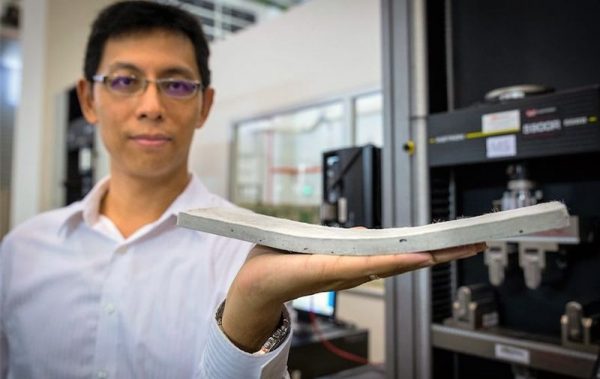Concrete, which we perceive as a model of reliability and durability, is actually quite fragile material. During operation, it quickly loses its qualities and is easily destroyed by external factors. Scientists are constantly working to improve this building material, trying to find a balance between its strength and ductility.
- Stretch concrete and its advantages
- Special additives in concrete
- Flexible concrete from Singaporean scientists
- Self-healing concrete

Stretch concrete and its advantages
A traditional concrete mortar consists of water, cement, gravel and sand. A mixture of these components gives a solid, heavy, but completely not flexible material. Under high pressure, microcracks form on its surface, subsequently leading to the destruction of the entire structure.
Elastobeton, in comparison with ordinary concrete mixes, is much lighter and more flexible. It does not break under heavy loads, does not crumble, cracks and voids do not appear in it. The influence of high loads causes such concrete to bend, while maintaining the integrity of the structure.
Increased elasticity is ensured by special polymer additives contained in the composition. They not only support the flexible properties of the material, but also improve the adhesion between substances and reinforcing structural elements.
Additives can increase the life of concrete products, improve their strength, reduce moisture permeability.
to contents ↑Special additives in concrete
There are several types of modifiers that improve the performance of concrete mixtures, namely:
- Plasticizers - increase the elasticity and strength of concrete coatings. Reduce the mass of the solution, reducing the load on the supports. Water resistance indicators are also improving.
- Antifreeze additives - reduce the hardening time of concrete, excluding its freezing at low temperatures. Excess liquid due to these additives does not freeze, destroying the plates, but evaporates.
- Retarders - reduce the setting period of the solution, relevant for long-term transportation.
- Accelerators - on the contrary, accelerate the hydration of cement and positively affect the strength of concrete blocks.
to contents ↑The complex use of modifying components simplifies and shortens the time for construction work.
Flexible concrete from Singaporean scientists
Researchers at Nanyang Technical University in the laboratory created an innovative building material. They developed and tested an improved version of the concrete mix called ConFlexPave. They plan to use their invention for laying prefabricated pavings.
The new material is not inferior in strength to metal products, and its elasticity is two times higher than that of standard cement mortars.
Key benefits of ConFlexPave:
- reduced load on the base due to the small mass of plates;
- saving labor and time for construction work;
- inexpensive maintenance;
- high wear resistance;
- increased flexibility;
- good slip resistance;
- rejection of bulky fittings.
The developers made an innovative discovery in the study of the interaction of substances at the microscopic level. They included polymer microfiber and a special solid mineral in ConFlexPave.
The content in the mixture of special synthetic components allows concrete to bend under the influence of high pressure. The finest fibers evenly distribute the load throughout the plate, and the solid components create a rough anti-slip relief of the coating. This minimizes the risk of vehicle skidding and ensures the safety of road users.
to contents ↑Self-healing concrete
Another innovative discovery, this time from scientists from the Netherlands, is concrete that can "heal itself" on its own. The material contains bacteria that can survive for a long time in an alkaline environment, even with a lack of oxygen and water. Their nutrient is calcium lactate, minimally affecting the key properties of concrete.
The main idea is that capsules with bacteria in a state of suspended animation are placed in a concrete solution. When a crack forms on the surface and moisture does not penetrate into it, microorganisms are activated and the process of production of calcareous matter starts. Lime fastens the resulting damage, restoring the original structure of elastic concrete.
Both projects are still in test mode. But the developers are confident that in the near future elastic concrete will become the main material for the construction of bridges, roads, earthquake-resistant monolithic structures.
Its only drawback is the higher cost compared to conventional cement mortars. However, this minus can not be called significant, given that the durability of the operation of the material will repeatedly cover the difference in price.









